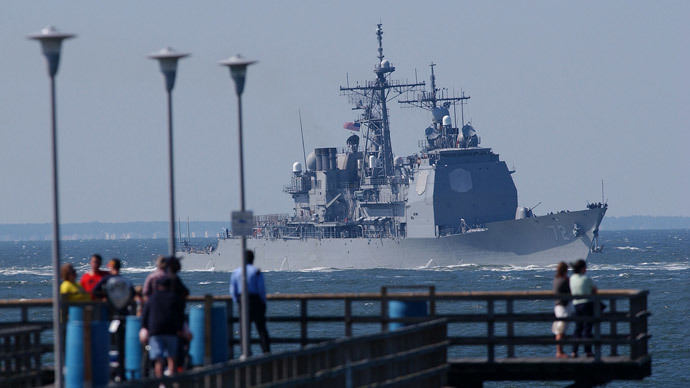US missile cruiser to enter Black Sea amid NATO drills in Eastern Europe – military source

The US missile cruiser Vella Gulf is expected to arrive in the Black Sea on May 23, a military source told a Russian news agency. Another NATO vessel is already in the area, while the French Navy’s stealth frigate will reportedly be there by late May.
This comes as part of a wider buildup of NATO forces close to Russian borders against the backdrop of the Ukraine crisis.
The American Aegis guided missile cruiser will be in the Black Sea in time for the Ukrainian presidential elections on May 25, a military-diplomatic source told Russia’s Itar-Tass news agency on Monday.
“It is expected that Vella Gulf will pass through the Black Sea straits on May 23. According to available data, the ship will be performing the tasks of US Navy command in the eastern part of the Black Sea,” the source said.
Another NATO vessel – a French stealth frigate, The Surcouf – is expected to enter the Black Sea between May 28 and May 29, reports RIA Novosti, also citing a military-diplomatic source.
Vella Gulf and The Surcouf will join the French Navy's intelligence ship, Dupuy de Lome, which is currently in the waters off Bulgaria’s port city of Varna. The vessel, designed for radar monitoring and capable of intercepting communications, including phone calls and e-mails, entered the Black Sea on May 14. Dupuy de Lome had also been present in the area from April 11 to April 30, a Russian Navy Main Staff spokesman told Interfax last week.
The US ship Vella Gulf is 172 meters long and 16 meters wide and can carry two multipurpose helicopters. It is also equipped with an Aegis air and ballistic missile defensive system, Tomahawk cruise missiles, antisubmarine missiles, as well as Standard-2 and Standard-3 surface-to-air missiles.
Vella Gulf will have to leave the Black Sea no later than June 13 as, according to the Montreux Convention, non-riparian, military vessels are only allowed to stay in the region for 21 days. It will replace US warship USS Donald Cook which left the Black Sea at the end of April.
The Pentagon claimed that during the Donald Cook’s deployment it was subject to a number of fly-overs by a Russian Su-24 aircraft. The craft reportedly made 12 low passes over the ship during a period of 90 minutes, prompting a sharp reaction from the US who slammed the move as “provocative.”

The Russian Foreign Ministry has previously accused NATO of violating the Montreux Convention, claiming the USS Taylor spent 11 more days than the limit in the region in February and March.
The expected deployment of the missile cruiser comes as NATO forces are beefing up their presence in Eastern Europe because of the ongoing crisis in Ukraine. Western leaders have accused Russia of purposely destabilizing its neighbor, something that the Russian government has categorically denied.
Last week, the Ukraine’s coup-appointed government deployed
15,000 troops on its border with Russia, provoking a sharp rebuke
from Moscow which said Ukraine and NATO were not contributing to
de-escalating the crisis in the region. Russia’s Deputy Defense
Minister Anatoly Antonov said that Russian troops had been pulled
back from the border zone.
However, NATO Secretary General Anders Fogh Rasmussen insisted on
Thursday that there had been no movement of Russian troops.
“I have very good vision but while we've noted Russia’s statement so far we haven't seen any - any - indication of troops pulling back,” Rasmussen said on his Twitter. “If we saw visible signs of a meaningful pullback by Russia troops, I'd be the first one to welcome it,” he added.
Elsewhere, in Eastern Europe, NATO has significantly increased its military presence and embarked on military drills. Earlier this month, the alliance began a 6,000-strong troop exercise called ‘Spring Storm’ in Estonia – the biggest since 2003 when the drill was first held.
Russia has condemned NATO’s activities and branded them as a provocation and not contributing to the normalization of the situation in Ukraine.















